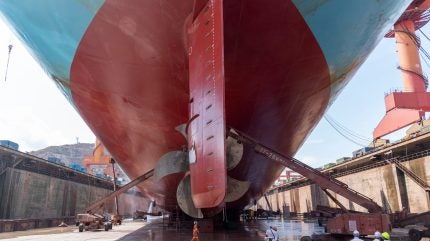
Maritime emissions are on everyone’s lips at the moment, after MEPC83’s apparent breakthough, but there are carrots that ship designers and operators can chase, along with the sticks regulators are using and planning to use, writes Matt Miller, Marine Industry Principal at AVEVA.
Efficient transportation of freight is crucial for today’s global economy. Whether raw materials or finished products, the majority of goods are likely to sail across an ocean at some point before reaching their final destination. With 80% of international trade dependent on shipping, according to figures from the UN, the environment is paying the price in greenhouse gas emissions.

Worldwide, the shipping and fishing industries combined are responsible for nearly 3% of all human-driven greenhouse gases (GHG). If this amount were produced by a country, it would be the sixth largest producer in the world.
On the upside, the intensity of carbon emissions is reducing. However, on its own, this won’t be enough to offset the projected increase in shipping over the coming decades, with emissions potentially rising to 130% by 2050 compared to 2008.
IMO setting course for sustainability
The IMO wants to see urgent action from the shipping industry to avert these damaging consequences. It has already committed to its 2023 IMO Strategy, going for net-zero emissions by 2050, aiming for a drop of 20-30% at 2030, and 70-80% by 2040.
To meet such an ambitious timescale, the IMO is promoting the uptake of zero and near-zero GHG emission technologies. It wants these types of fuel and alternative energy sources to represent 10% of international consumption but is targeting 5% as a minimum by 2030.

US Tariffs are shifting - will you react or anticipate?
Don’t let policy changes catch you off guard. Stay proactive with real-time data and expert analysis.
By GlobalDataBetter fuel performance is also seen as a key factor in lowering emissions. The aim is to reduce carbon intensity per transport work by at least 40% by 2030 compared to 2008. Effectively, this means ships must use less fuel and produce fewer emissions relative to the distance they travel.
Regulators making waves
It’s not only the IMO that’s making waves, the EU’s FuelEU initiative mandates the use of more sustainable fuels to reduce maritime GHG, with strict targets starting to come into force from 2025.
Penalties in the coming years for non-compliance are likely to be substantial as part of the IMO and EU’s enforcement strategies. These could include fining shipping companies and detaining ships in port, resulting in significant financial losses and long-term reputational damage for the perpetrators.
To be ready for approaching regulatory obligations, shipping companies must act faster. Ignoring sustainability is no longer an option. Forward-thinking organisations are already driving innovation across the ecosystem, embracing new technology and designs to replace or upgrade ageing vessels, facilities and processes. This means they are in a good position to ramp up the transition to cleaner fuels, better performance, and more efficient energy usage across all operations.
Improving the quality and timeliness of decision-making is the first step in the ability to build automated processes. An operational System of Record (SoR) with a strong foundational data infrastructure provides a single source of truth for decision making. This enables the team to focus on approaches which have the most impact and accelerate the time to value.
Accelerating progress with digitalisation
There’s considerable scope for faster progress in the short-term from leveraging readily available digital tools. One of the most transformative digital technologies emerging in the maritime industry is the concept of the Digital Twin – a virtual replica or model of a physical asset, process, or system that can be used for analysis, simulation, and control. In the maritime context, this extends to vessels, ports, cargo, and even the broader logistics network.
Digital Twins allow for real-time monitoring and simulation of a ship’s systems and operations, creating opportunities for enhanced decision-making, predictive maintenance, and more efficient operations. For example, a Digital Twin can replicate a ship’s hull condition, machinery, or even its entire operational profile, enabling shore-based teams and onboard crew to understand the ship’s performance under various conditions without being physically present or conducting multitudes of actual trials.
This can have significant sustainability benefits – such as optimising vessel and fleet operations, leading to significant fuel savings and reduced emissions. Predictive analytics provided by Digital Twins also allow ship operators to perform maintenance only when necessary, reducing downtime and extending the life of the vessel. By simulating how a ship operates under various conditions, Digital Twins can ensure compliance with environmental and safety regulations. With reduced resource consumption and lower emissions, the technology can contribute to a more sustainable maritime industry.
The following applications demonstrate just a small sample of the impact areas to explore.
1. Efficient Vessel Design
Instead of inflexible 2D modelling, today’s 3D modelling software platforms offer sophisticated features, including centralised repositories to facilitate collaboration across teams. These systems streamline the design process of sustainable engineering projects, automating checking and reducing design errors.
As an example, Japan’s Namura Shipbuilding, has digitalised the engineering of its vessels and bridges, meeting internal efficiency goals for new vessel designs and growth in cargo movement. This has led to an improvement in design quality as well as a 10% cut in time.
2. Optimised Vessel Operations
Maximising fuel efficiency of existing vessels is an ongoing priority, requiring constant monitoring and complex data analytics. CSL Group is already taking advantage of advanced data management and machine learning algorithms to optimise fuel consumption and identify maintenance problems before they occur across over 40 vessels. As a result, it has avoided costly fleet asset failures and achieved 29% of carbon intensity reduction since rolling out the solution.
3. Seamless Digital Integration from Ship Design to Real-time Operations
Managing the full lifecycle of complex marine assets, from design and construction to real-time operational monitoring, requires seamless data integration. Yinson, a global floating production, storage, and offloading vessel operator, has transformed how it designs, builds, and operates its fleet by leveraging digital tools for end-to-end asset and performance management.
By integrating advanced digital engineering solutions during the design and build phases, Yinson ensures consistency, efficiency, and data continuity across the vessel lifecycle. Once in operation, real-time asset monitoring enables daily data consolidation, improving maintenance efficiency, optimising performance, and enhancing collaboration across teams. Additionally, continuous emissions tracking helps Yinson measure and reduce its environmental footprint, supporting its goal of net-zero emissions by 2050.
Eyes on the horizon
Adopting digitalisation can reduce emissions by 15% by 2050, according to maritime experts DNV. This could be pivotal for meeting environmental regulations and avoiding the ramifications of non-compliance. But while sustainability must be the top priority, there is far more to gain from introducing new technologies. Digitalisation could transform the shipping industry, driving unprecedented levels of design innovation and rejuvenating ageing infrastructures. It will play a crucial role in securing a modern, greener maritime future.



